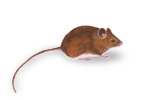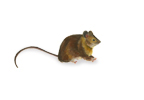Mice
Mice are a small mammal belonging to the order of rodents. The best known mouse species is the common house mouse (Mus musculus). In some places, certain kinds of field mice are also common. This rodent is eaten by large birds such as hawks and eagles. They are known to invade homes for food and occasionally shelter.
In nature, mice are herbivores, consuming any kind of fruit or grain from plants. Due to this, mice adapt well to urban areas and are known for eating most all types of food scraps. In captivity, mice are commonly fed commercial pelleted mouse diet. These diets are nutritionally complete, but they still need a large variety of vegetables. Food intake is approximately 15 g (0.53 oz) per 100 g (3.5 oz) of body weight per day; water intake is approximately 15 ml (0.53 imp fl oz; 0.51 US fl oz) per 100 g of body weight per day.
House Mouse
Mus domesticus
Appearance

• 7 – 9.5cm in length, with a tail around the same length.
• 12 – 30g in weight.
• Their relatively small feet & head and large eyes & ears distinguish them from a young brown rat (Rattus norvegicus).
Lifecycle
• 4 – 16 young per litter; 7 – 8 litters a year.
• Gestation period of about 3 weeks
• 8 – 12 weeks from birth to sexual maturity
Habits
• Usually ground living and burrowing, but often climbs.
• Preferred food is cereals
• Will eat around 3g of food a day and can survive without any additional water. They will drink up to 3ml a day if their diet is particularly dry.
• Widespread and relatively cosmopolitan, this species is a frequent pest of homes and Industrial sites. Urinating frequently, and feeding from multiple sites, food spoilage and the spread of disease.
• Control The combined use of monitoring equipment, baits and physical control methods where appropriate is recommended. Bait formulation is an important factor, due to the high specificity of food selection by this species.
Field Mouse
Apodemus sylvaticus
Appearance

• Adults: Head and body 80 – 100mm; Tail 70 – 90mm.
• Male can weigh 25g, and the female 20g.
• They have fur which is sandy / orange brown on the head and back, yellowish on the flanks and white on the belly. There is usually a small streak of yellow on the chest.
Lifecycle
• Their lifespan averages two to three months, but they can survive as much as 20 months in the wild, or two or more years in captivity
• The breeding seasons are March/April to October/November and gestation lasts approximately 25 days. They grow their first fur after six days; their eyes open after 16; and they are weaned at around 18 days old.
• Survival of the young and adults is poor during the first half of the breeding season as adult males can be aggressive towards one another and to the young, who are then driven from the nest.
Habits
• They eat a high proportion of the seed crop of trees such as oak, beech, ash, lime, hawthorn and sycamore.
• Small snails and insects are particularly important sources of food in late spring and early summer when seeds are least available and larval and adult insects are plentiful.
Yellow Necked Field Mouse
Apodemus flavicollis
Appearance

• Adults: Head and body: 95 to 120 mm; tail 75 – 110mm. Weight ranges between 14 and 45g.
• They have brown fur on their backs and white on the underside with a distinctive complete band of yellow fur around the neck.
• They have large ears, protruding eyes and a long tail.
Lifecycle
• Breeding occurs from March or April until October, with gestation taking 25 or 26 days.
• Young are fully weaned after about 18 days and usually start to breed the year following their birth.
• Most mice do not survive longer than 12 months.
Habits
• They can spoil or consume stored food or interfere with electrical wiring.
• They prefer mature broad-leafed woodland and habitats such as hedges, rural gardens and buildings.
• They are more likely to enter buildings than wood mice (Apodemus sylvaticus).


